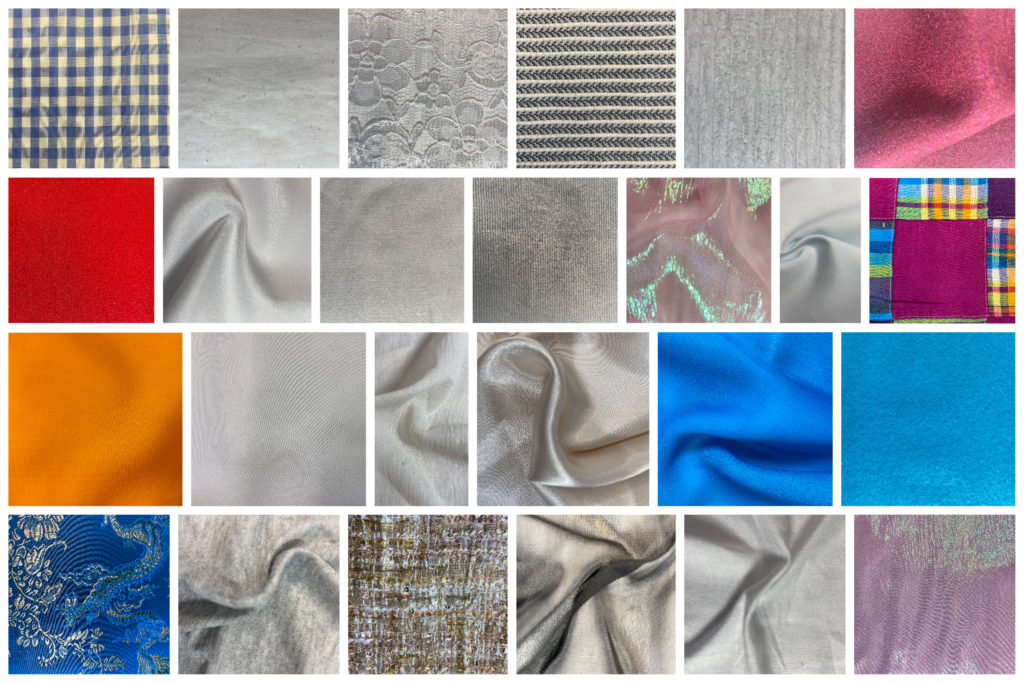
Textiles have a long and rich history. Fabrics have been around almost as long as human civilization! Over time, people developed many fabrics, from classic corduroy to sweet chiffon to quintessential denim.
As styles change and new materials become available, like synthetics, the list of fabrics grows. Keep reading to learn the origins, uses, and creative processes of more than fifty well-known fabrics.
Cotton
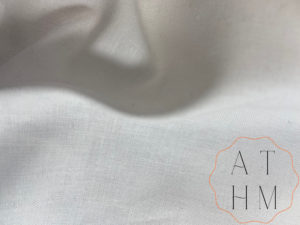
Cotton is one of the most commonly used fabrics in the world, especially for clothing. It’s a chemically organic material, meaning it’s a natural fabric. To make cotton, one separates the fluffy fibers from the seeds and then spins them into thin threads.
These fibers then weave together using a plain weave usually. It has a soft texture, is breathable, and can moderately retain heat, so it works for all seasons. It originated in ancient India around 5,000 BC.
There are four types of cotton: Pima, Egyptian, upland, and organic. Both Pima and Egyptian are fine fibers, making for high-quality clothing and products. Upland and organic cotton are more common, compromising 90% of the world’s cotton production.
The uses of cotton are endless. Cotton is a commonplace fabric for making shirts, pants, suits, dresses, underwear, socks, towels, and bed sheets.
For more information, see our full guide to Cotton Fabric.
Silk
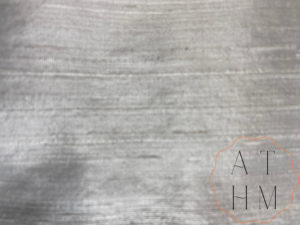
Silk fabric uses natural protein fibers made by silkworms. There are silkworm insect farms where large amounts of these fibers are collected and woven into fabric. Silk fabric uses the satin weave, resulting in a super soft and smooth texture with flowing movement.
It’s one of the most breathable materials but also one of the most delicate. It can easily catch, resulting in snags and damage to the weave. The fabric originated in China around 4,000 BC, originally used to wrap the corpses of children.
Today, the fashion industry uses it for luxury items like lingerie, nightgowns, robes, eveningwear, suits, blouses, and skirts. It’s also a popular material for pillowcases and sheets, as the material is gentle on sensitive skin.
For more information, see our full guide on Silk Fabric.
Chiffon
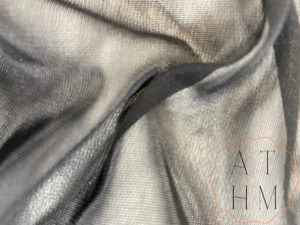
Chiffon is a sheer, lightweight fabric commonly used in evening wear, nightgowns, blouses, lingerie, scarves, and wedding dresses. It’s seen as a luxurious fabric and made using silk, cotton, nylon, polyester, or rayon.
It’s most commonly silk, for the highest quality type of chiffon. Chiffon uses a plain weave, usually with long, thin fibers, creating a whimsical, sheer appearance. The invention of chiffon occurred in France during the 1800s but is now mostly made in China.
High-quality chiffon is a natural fabric made from silk, but there are also polyester varieties of chiffon, which are synthetic fabrics. Unlike most modern fabrics, chiffon is still often woven by hand because of its fragile nature.
It’s also a slippery fabric, so it takes skilled sewers and weavers to craft it. Similar to silk, it can easily snag on objects, making it hard to care for and keep for a long time.
For more information, see our full guide on Chiffon Fabric.
Wool
Wool is one of the heartier natural fabrics and can use a plain or twill weave, depending on the style. The fibers come from animal hair, typically sheep or alpacas. Wool can also come from goat, camel, yak, or llama.
Depending on the quality of the wool fibers and type of weave, the fabric is fleece, cashmere, fur, hair, or tweed. Tweed involves when the wool fabric has a twill weave. Cashmere only uses the highest-quality, thinnest fibers.
By spinning the animal hairs together, the weaver makes delicate fibers. Wool is one of the most popular winter fabrics because it has excellent heat retention, so people use it for sweaters, socks, hats, scarves, suits, and gloves.
Wool was first invented in ancient Iran. Today, Australia is the the largest wool manufacturer in the world, thanks to their extremely large sheep population.
Read more at our Wool Fabric Guide.
Linen
Linen is a durable fiber made from the stalks of flax plants. It is one of the most ancient fabrics, with a history dating back at least 38,000 years.
Linen is similar to cotton in that it is soft, breathable, and lightweight. Linen is one of the most versatile fabrics, it can make many products including: bed sheets, pillowcases, towels, shirts, dresses, pants, suits, and skirts. It’s slightly stiffer than cotton but comfortable to wear.
It’s typically a natural fabric, but you can also buy polyester-linen blends, which are both synthetic and natural. Some people call linen “flax fabric,” but linen is the most agreed-upon name for this fabric.
For more information see our Linen Fabric Guide.
Polyester
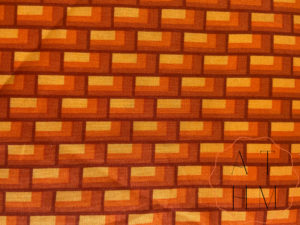
Polyester is the most common synthetic fabric. Polyester fibers are a type of plastic developed in a lab using chemicals.
A chemical reaction between petroleum, air, and water results in polyethylene terephthalate. W. H. Caruthers invented the material in the 1930s in a US laboratory. Despite being a variety of plastic, polyester is soft and flexible.
It’s a popular and affordable choice for making all sorts of clothing and textile products, like sheets, towels, dresses, pants, shirts, blouses, underwear, socks, jackets, blankets, and hoodies. Polyester has no particular weave, as it can work with many weave variations.
For more information, see our guide on Polyester Fabric.
Denim
Denim, also called jeans, is an iconic material that has been popular in the fashion industry for decades. From jean jackets to pants to shorts, practically every modern person owns at least one denim item.
Denim uses cotton fibers in a twill weave to create the diagonal ribbing pattern. The key to making denim is using two different colored threads in the twill pattern, creating a distinct texture and appearance.
Like cotton, most denim is a natural fabric, but some varieties are polyester blends. Usually, it’s a white or cream thread paired with a blue one. The warp-faced weaving style makes it a super strong and durable material. It originated in both France and USA close to the same time in the late 1800s.
See our full guide on Denim Fabric.
Crepe
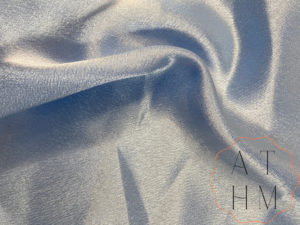
Crepe, the fabric, not the thin pancake, is similar to chiffon in lightness and sheerness. It originated in England in the early 1800s and is best for scarves, shawls, dresses, eveningwear, and high fashion. It’s also a popular material for curtains.
Crepe fabric can be synthetic or natural depending on the fibers used, which can be silk, wool, or polyester. Crepe uses the satin weave, which gives it a light and airy feeling.
In a satin weave, one thread floats above the other, and crepe fabrics do this exceptionally. Other rare names for this fabric include crape, crepon, crespe, and crisp.
For more information see our full guide on Crepe Fabric.
Rayon
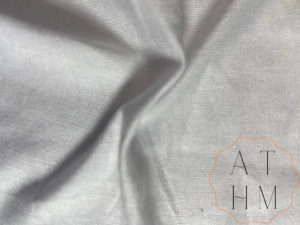
Rayon is a fascinating fabric because it’s semi-synthetic, combining synthetic fibers with natural ones. It’s a highly sustainable fabric because it uses cellulose from natural sources, such as wood or agricultural products.
The cellulose adds durability, but the organic material keeps it soft and free of excessive chemicals. While rayon isn’t ideal for the environment, many consider it a far better option than polyester and other synthetic materials.
Rayon tends to have a satin weave to create a soft and silky texture but can also use the plain weave for more casual products. The fabric originated in the US in 1846, originally called artificial silk and later changed to rayon.
For more information see our full guide on Rayon Fabric.
Flannel

What would a chilly autumn day be without your favorite flannel button-down? Flannel, like denim, has become an iconic and beloved fabric in the fashion industry for its comfort and heat retention capabilities.
It’s ideal for winterwear, like heavy button-downs, jackets, shirts, pants, socks, hats, and scarves. But it’s also a popular material for pajamas, blankets, and sometimes sheets. Flannel does not have to have a plaid or buff check pattern, but it often does as this has become the norm.
Also called flannelle or flanell, this material likely originated in Wales, but its originals are slightly mysterious. The fabric uses the twill weave usually, but lower-quality flannel can be a plain weave.
The best flannel fabrics use wool fibers, but flannel can also use thick cotton fibers or synthetics. But natural flannel fabrics are typically the warmest, most comfortable, and the most expensive.
Velvet
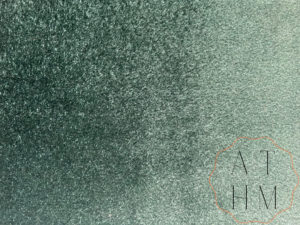
Velvet is one of the most lustrous fabrics, with a fuzzy, smooth texture that appeals to people. It uses a unique weave called the pile weave, which creates 3D textures on the fabric.
Velvet can only use a pile weave, which features multiple layers that make the fabric incredibly soft. The threads bunch together tightly, and the fibers can be silk, cotton, or synthetic. Velvets come in a wide range of quality based on the fibers chosen.
Another distinct characteristic of velvet is that it’s starkly different on either side, with only one being soft and fuzzy and the other being smooth and plain. Also called velveto or velveteen, the fabric came from East Asia, but its exact origins are unknown.
People enjoy using velvet for dresses, skirts, blouses, sweaters, upholstery, drapes, eveningwear, robes, and bedding.
Fleece
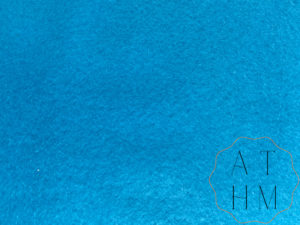
Fleece is a variety of wool made using particular fibers and weaves. Fleece is always a synthetic fabric, using polyester fibers in a plain weave.
The fibers are typically thick and short but don’t have to be. Fleece is a much lower quality fabric than most wools or flannels, but it’s still cozy and has decent heat retention. People often use it to make cardigans, jackets, shirts, blankets, sweaters, sweatpants, vests, and hats.
It originated in the US in the early 1980s, so it’s still a relatively new fabric. It often has a puffy, fuzzy texture that is pretty thick. Like velvet, sometimes only one side of the fabric has the intended texture, while the other is plain and smooth.
Fleece is an affordable material, so people often choose it over authentic wool, flannel, or cashmere.
Corduroy
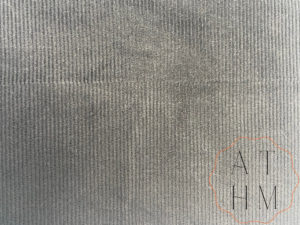
Corduroy is a thick and durable fabric, usually made from cotton or polyester. Corduroy has a distinct ribbed appearance and velvety texture.
Corduroy has a unique creation process: It’s always a twill weave with one warp and two filling threads, which create the ribbing pattern., After it’s woven, the back gets a glue coating to prevent the ribbing from releasing when cutting the fabric.
The fabric originates from Manchester, England, in the 1800s. Some people refer to the fabric as “Manchester,” but this is typically only in Europe.
Corduroy is generally used for heavy clothing items, like pants, overalls, jackets, shirts, dresses, and sometimes upholstery. It has a velvety texture but can also be stiff and rough.
Chenille
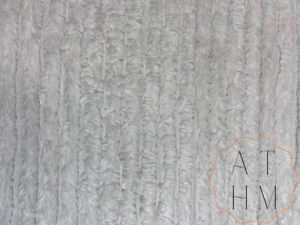
Chenille is a tough fabric most commonly used for furniture but does find its way into some clothing items. It’s a synthetic fabric, so it’s more affordable than similar fabrics. It can feature silk, wool, or cotton fibers but always has some combination of synthetic threads too.
The texture of the fabric is soft and fuzzy. It uses a plain weave but can also utilize a twill weave if the product should be thicker.
To make chenille, the weaver wraps two yarns around one thread, creating small loops consisting of thick yarn over the thin thread. This weave results in a stripey-looking fabric, as you only notice the yarn going in one direction.
Alexander Buchanan invented the textile in the 1830s in Scotland. Today, it’s common in home goods, like quilts, carpets, and bedspreads. But some sweaters, cardigans, robes, gloves, and coats use chenille fabric.
For more information see our full guide on Chenille Fabric.
Satin
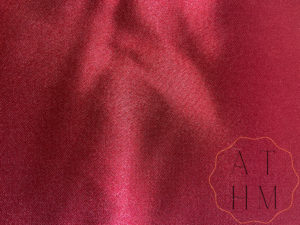
Satin is one of the most popular fabrics. Many confuse it with silk, but the key difference is that satin is typically a synthetic made from a combination of fibers, natural and synthetic. It’s still silky soft but not as luxurious as pure silk.
Many see satin as the knock-off version of silk. However, the weave is similar, as both use the satin weave, creating airy, flowing fabrics. Silk is also shiny on both sides, while satin is only glossy on one side.
Satin varieties originated in the ancient world, likely in China. People use it for the same products as silk to create more affordable options. You can find satin dresses, skirts, nightgowns, blouses, shirts, robes, and bedding.
While satin features a synthetic fiber, it’s often paired with silk, cotton, or wool fibers for a rich texture.
For more information see our full guide on Satin Fabric.
Muslin
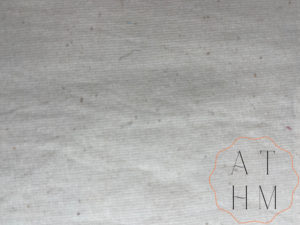
Muslin is one of the plainest fabrics and is similar to linen. It uses a plain weave and cotton fibers. The difference between linen and muslin is the looseness of the weave, making muslin the thinner and more breathable option.
It’s versatile but not the most desirable fabric, as it lacks softness and flair. It dates back to ancient times and was first in Iraq.
While muslin works well for summer dresses, suits, pants, skirts, and tops, it’s most common in bedding and other home goods. It’s also a textile used in art, like photography or painting, thanks to its simplicity.
For more information see our full guide on Muslin Fabric.
Nylon
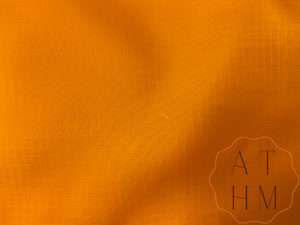
Nylon is a 100% synthetic material with excellent stretch and give, making it a top choice for active wear.
It originated in the US 1930s and quickly became popular, thanks to its formfitting qualities. It combines various synthetic polymers woven together with the plain weave. Nylon can be sheer or thick and opaque, depending on the fibers and tightness of the weave.
This fabric influenced society’s gravitation toward athleisure and workout wear. It’s in stockings, tights, sportswear, yoga pants, leggings, and similar items. It’s a cheap fabric made from plastics and doesn’t seem to have any place in high fashion.
For more information see our full guide on Nylon Fabric.
Organza

Organza is a stunning material with a dramatic effect. It’s often in wedding dresses, gowns, eveningwear, scarves, blouses, and other luxurious items.
It’s a super sheer fabric with a shiny appearance and soft texture. It can use synthetic fibers like polyester, but the highest-quality organza uses silk fibers and a very loose satin weave. The material originated in Turkestan during the Middle Ages.
It was popular among royals and the upper class. Not much has changed today, as organza is rarely used in casual daywear and reserved for fancier products.
While organza is delicate, it tends to be more durable than silk or satin but can still catch on objects if you’re not careful.
See our full Organza Fabric Guide.
Georgette
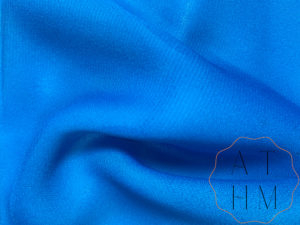
Georgette is a lesser-known fabric but falls into the same category as silk, chiffon, and crepe. It’s a lightweight, matte material that uses the satin weave with twisted yarns.
It usually uses pure silk fibers, but cheaper versions can use synthetics like rayon, viscose, and polyester. What sets Georgette fabric apart is the slight crinkles effect on the surface, adding more texture and dimension than simple silk or satin.
The crinkle effect is due to the unusual tightness of the satin weave, which is usually a looser weave. It also has a dull, matte finish rather than shiny and silky, which is luxurious in its own way.
Dressmaker Georgette de la Plante invented the fabric in France during the 1900s, and it remained a popular fabric for dresses, skirts, evening wear, blouses, and scarves.
See our full guide on Georgette Fabric.
Gingham
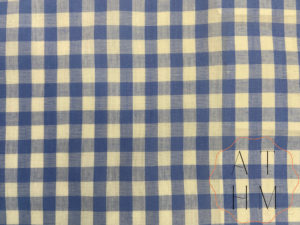
Gingham is an unmistakable fabric that originated in Malaysia and Indonesia in the 1600s, if not earlier. It uses cotton or synthetic fibers like olefin, so it can be synthetic or natural.
It has a flat, lustrous appearance, which some see as plain, while others find it alluring and happy. Gingham has a memorable checker appearance, so it often makes decent curtains, towels, and other home goods, particularly kitchen textiles.
It uses a plain weave, so the fabric isn’t very complicated or expensive to produce. The colorful pattern makes it unique, so the dyeing process is usually the most important aspect of creating Gingham.
It’s lately fallen out of style but once made loads of shirts, dresses, aprons, button-downs, and even suits.
Cambric
Cambric is similar to linen and cotton but has a tighter plain weave, making it more durable but less breathable. It’s also slightly heavier than linen.
It originated in Cambrai, France, in the 19th century and is commonly used to make dresses, skirts, suits, shirts, blouses, curtains, handkerchiefs, underwear, and pajamas. It’s also a standard fabric for making children’s clothes because of its durability and comfort.
Another notable difference between cambric and cotton is the fiber length. Camric uses short, tightly twisted fibers, making for a material with less stretch but more strength.
Taffeta
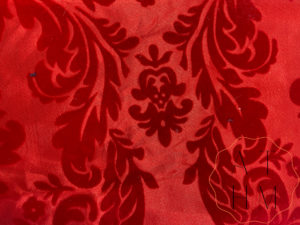
Taffeta, also called paper taffeta or shot silk, is a heavy, shiny fabric usually reserved for fancy attire. People use it to make wedding gowns, blouses, evening wear, curtains, and even sleeping bags.
It’s a synthetic blended fabric that uses tightly spun polyester fibers with silk fibers. A vital part of making taffeta is stretching the polyester and silk fibers so the material is slightly stiff and dense.
It uses a satin weave to create the soft, silky texture you expect from a fabric made with silk. It dates back to the 1100s, originating in the Middle East near Persia.
Jersey
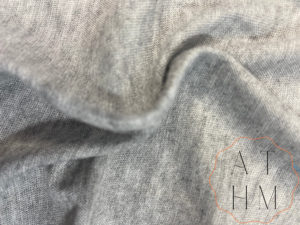
Jersey is one of the most flexible fabrics in the fashion industry. Sometimes called a jersey knit, the fabric uses wool, cotton, synthetic fibers, or a combination of these in a plain weave.
It’s breathable and has excellent stretch, making for comfortable but formfitting clothing. It came from the Channel Islands in 1916, originally used to make underwear, socks, and other necessities.
But Coco Chanel chose to use the fabric for high fashion and elegant attire, changing how the world viewed this affordable fabric. It’s still used to make underwear and socks, but it’s also for t-shirts, sweaters, dresses, blouses, polo shirts, athletic wear, and bedding.
Poplin
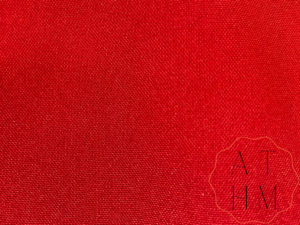
Poplin uses a tight plain or satin weave to create a soft fabric commonly used for dress shirts, pants, suits, dresses, pajamas, and children’s clothing. It’s breathable and light but still durable and long-lasting.
It has an airy feeling that helps you stay cool in the hot months. It’s also easy to dye and print on, making it a popular choice in the fashion industry. Poplin traditionally used silk fibers combined with wool weft threads.
Now, people make poplin with an array of materials, like cotton, polyester, and lycra. It came about in the 1400s in Avignon, France, using a silk warp and wool weft for soft yet dense material.
Gabardine
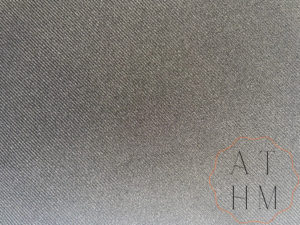
Gabardine is a natural fabric made from cotton fibers, silk fibers, or a combination of the two. It’s made with the twill weave, creating a firm cloth for suits, jackets, overcoats, pants, and other outerwear.
It’s semi-waterproof, so it’s a common material for stylish raincoats. But it’s not the most affordable option.
The Burberry company gets credit for making this material popular, and
Thomas Burberry himself invented the fabric in 1888 to make fashionable but functional peacoats and rain jackets.
It has a rough, wool-like appearance but is surprisingly soft to the touch with a silky smooth texture. The soft feeling is due to the super tight twill weave.
Leather
When discussing fabrics, leather is a different beast. Rather than being a woven fabric with fibers and threads, leather is rawhide or animal skin stretched and tanned into a relatively flexible material.
Leather has prehistoric origins, so its true history is unknown. People use it to make jackets, coats, wallets, belts, vegas, gloves, upholstery, luggage, and more. It’s one of the most durable and rugged fabrics but tends to wear with age.
However, worn leather is sometimes the desired texture, as it softens with age and becomes more flexible. It has a shiny, rich texture, which can vary.
Genuine leather is real animal hide, therefore a natural fabric. But today, there is also imitation leather made from polyvinyl chloride.
Bamboo Fabric
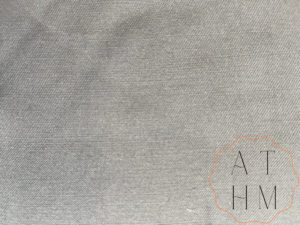
One of the most sustainable kinds of fabric is bamboo fabric! Bamboo fabric can also be known as bamboo rayon, bamboo yarn, retting, or bamboo linen.
Bamboo is one of the fastest-growing and low-maintenance plants, making it easy to produce large amounts of bamboo fabric at a low cost and with little harm to the environment. The threads come from semi-synthetic viscose cellulose.
This cellulose comes from the bamboo flat via an extraction process. Another option is thin bamboo fibers that can be spun together to make bamboo yarn! Unsurprisingly, bamboo fabric originated in East Asia, where bamboo trees are plentiful.
Its likely bamboo fabric has been around for centuries, but it wasn’t patented until 1864. Bamboo fabric is breathable and water-resistant. It’s also extremely stretchy, making it a super comfortable material for making clothing.
People use bamboo fabric for shirts, dresses, pants, shorts, pajamas, and bedding materials.
Chintz
Chintz originated in India in the 1500s and is a lesser-known and used fabric in the modern world. It’s a plain-weave cotton fabric that has a polished finish that looks like it has a slight glaze.
People sometimes call it “polished cotton.” Traditionally, chintz uses dyes or prints with large, bold designs, often florals. The fabric works for dramatic attire, like costumes and formal wear, and home textiles, like kitchen towels.
Because chintz is a natural fabric made from cotton fibers and a plain weave, people often wonder what makes it special. The fabric’s tight-weave and glossy finish work well with dyes and prints, so most chintz you find will have these flourishing patterns.
Lace
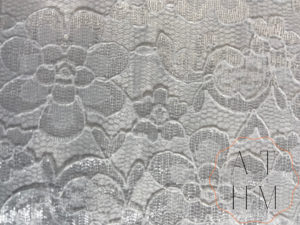
You probably know what lace is, as it’s one of the world’s most popular fabrics. Lace can be practically any kind of fiber, including linen, silk, cotton, synthetic fibers, and even some precious metals!
Lace originated in Europe, but its exact origins are unclear. Lace is common in wedding dresses, shawls, scarves, lingerie, accessories, dresses, and eveningwear. Lace is a delicate, open-weave fabric that has a sexy connotation with a luxurious and fancy feeling.
The texture will depend on the type of fiber used. Silk lace will be smooth and slippery, while polyester lace will be plainer and less shiny.
Lawn Fabric
Despite the name, lawn fabric is not for your front lawn or backyard. It’s a natural cotton fabric invented in France during the 1500s.
It’s also called lawn fiber, lawn, batiste, or cotton lawn. It’s common in blouses, shirts, dresses, lingerie, suits, and handkerchiefs. Lawn fabric has a higher thread count than average cotton fabrics, making it silkier than linen or muslin.
The cotton yarn is also combed, meaning it’s finer and smoother than average cotton fibers. Most lawn fabrics have a peppy pattern or dye job, like dainty flowers, making them a popular choice for summerwear and children’s clothing. It has a clean and luxurious appearance and texture.
Spandex

Spandex does not often appear in high fashion, but general society has welcomed this stretchy, breathable fabric with open arms. When it originated in the US in 1959, it was called lycra or elastane.
It’s mostly for athletic wear, yoga pants, leggings, skinny jeans or “jeggings,” underwear, bras, socks, and headbands. Spandex is a completely synthetic fabric made from the polyether-polyurea copolymer.
It can be shiny or dull, depending on the type of plastic fibers used. Spandex is probably the most stretchy and elastic fabric in existence, making it the top choice for workout wear. It has a soft feeling, but nothing compared to silk or chiffon.
Viole
Viole is similar to lawn fabric, as it almost always has some sort of floral or nature-themed print on it. It is either made of 100% cotton, like lawn fabric, but can also be a cotton and synthetic blend.
It uses a tight plain weave for a silky soft finish, and the cotton fibers are much thinner than the threads used for lawn fabric. So this material is more flowy and delicate. Unlike spandex, viole doesn’t stretch, which can make it hard to wear or work with.
It’s slightly transparent but not sheer like chiffon or organza. It’s thought to have originated in Spain late in the 1400s and, to this day, is ideal for dress shirts, tunics, skirts, sundresses, scarves, and lingerie.
Damask
Damask uses an intricate weaving technique that combines warp-faced satin weaves with weft-faced sateen weaves.
It can be silk, cotton, or polyester. But natural damask fabrics are more popular and more common. It originated in ancient Syria and is not super popular in the modern world.
However, people sometimes use it to make evening gowns, shirts, jackets, and scarves. But most uses revoked around upholstery, tablecloths, rugs, tapestries, and other home textiles.
Gauze
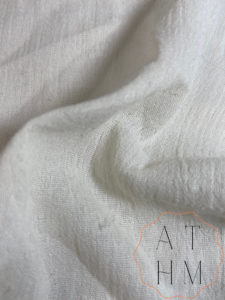
When most people hear “gauze,” their mind goes toward medical equipment and bandages. But gauze fabric also has a place in the fashion industry as a lightweight and casual fabric used to make dresses, blouses, shirts, children’s clothing, and other loose attire.
The very same fabric is what doctors and nurses use to wrap wounds and what you can probably find in your first aid kit. It originated in the middle of the 1500s in Gaza, Palestine, hence the name.
It uses a plain open weave, much looser than other plain weaves. It can use cotton, wool, silk, or synthetic fibers, but cotton is by far the most common.
Sateen
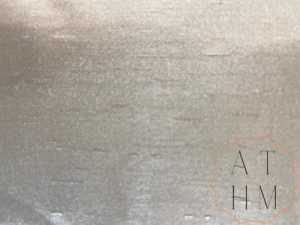
Sateen fabric is defined by the type of weave, which is a sateen weave. A sateen weave uses one yarn under, with three or four yarns over, giving the fabric a heavier weight that many feel is luxurious.
Sateen can use cotton, silk, polyester, or rayon. The quality of the sateen will depend on the material used, with silk being the softest and most expensive.
The sateen weave is thought to have developed during the 12th century in Europe, but it’s unclear who did the first sateen weave.
People use sateen in the same way they use silk and satin for dresses, lingerie, nightgowns, slips, bed sheets, pillowcases, suit vests, and other fancy items.
Batiste
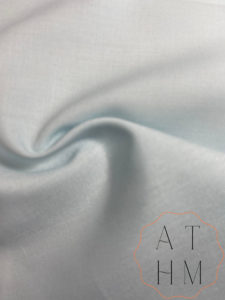
Batiste, often compared closely with lawn fabric, is a semi-synthetic fabric made from cotton and polyester. It was first produced in France in the 1200s.
Today, it’s popular for down comforters and other items where softness and durability are equally important. It’s often used to line clothes rather than being the main material in the garment.
It has a lightweight feel with a semi-sheer appearance. It has a typically plain weave that’s most common in the textile industry. Batiste is highly durable and semi-soft, making it a good filler fabric for clothing.
Canvas
Most people are familiar with canvas, but not in their clothing. Other names for canvas include duck, tarp, fly, awning, or tenting fabric. It uses a plain weave with cotton fibers that have been chemically treated with PVC or gesso to be stiffer.
It has little stretch but high moisture-wicking capabilities, making it useful for artists. The origins of the canvas fabric are unclear.
Some believe it came about in Italy in the 13th century, but there is some evidence that ancient Greeks made canvas from hemp plants.
People typically use canvas for bags, tents, tarps, pants, and backpacks. But as mentioned, they’re commonly used as art supplies.
Cashmere

One of the softest and most luxurious fabrics you can buy is cashmere. Cashmere is expensive and complex to make, as the fibers must be fine and come from specific animals.
Cashmere is a type of wool, the most refined type of wool. It only uses softly spun and combed wool fibers from either cashmere or pashmina goats. It’s a popular material for sweaters, hats, dresses, shirts, socks, thermal clothing, hosiery, scarves, gloves, and even underwear.
It’s incredibly silky to the touch but has the thickness and warmth of wool. It originated in the Kashmir region near the Gobi desert, and some refer to it as Kashmir instead of cashmere.
Brocade
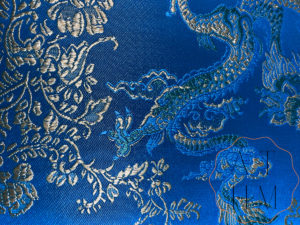
Brocade is an embossed type of fabric made from thick yarns. It usually consists of a mixture of different materials, including silk, cotton, and polyester.
It originally came from ancient China and is a decent fabric for making dresses, costumes, trousers, jackets, and suits. It’s also often used to make drapes and upholstery because of its thickness and bold appearance.
This patterned and woven fabric is special because the patterns are part of the weave rather than embroidered on top. The patterns are intricate and often abstract, traditionally only used for ornamental garments like costumes or dramatic eveningwear.
Acrylic Cloth
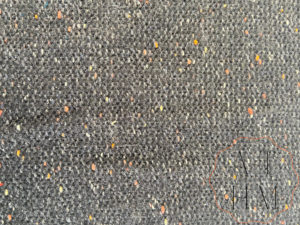
As the name implies, acrylic cloth is a completely synthetic plain weave cloth made from synthetic polyacrylonitrile polymer fibers.
It’s sometimes called polyacrylonitrile or acrylonitrile, but acrylic is the common name for it. The acrylic cloth was first manufactured in Germany in 1893 and quickly became popular in America because of its durability and affordability.
It can make practically anything. The most common uses are sweaters, hoodies, boots, boot lining, hats, athletic wear, gloves, wigs, hair extensions, and protective clothing. It also has a place in many home goods like carpets, blankets, and upholstery.
Hemp Fabric
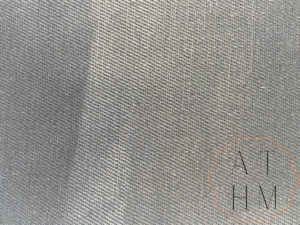
Similar to bamboo fabric, hemp fabric is the future of textiles because of its affordability and sustainability. Hemp is a versatile plant that can make clothing, toiletries, and more, so it has a lot of potential in the textile industry.
Industrial hemp fabric comes from fibers from stems of Cannabis Sativa plants. Hemp fabric does not contain marijuana, as it’s a different part of the plant. Hemp fabric originated in Asia and the Middle East many centuries ago.
Hemp is one of the most breathable and low-maintenance fabrics, making it a popular material for children’s clothing, bedding, towels, pajamas, shirts, pants, athletic wear, hoodies, underwear, socks, and even rugs!
Hemp fabric uses two layers. The outer layer is rope-like fibers, while the inner layer is a woody pith. This layer makes for a durable but lightweight fabric suitable for many uses.
Tweed
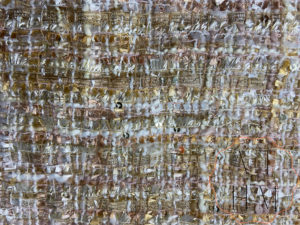
Tweed is one of the most fun and funky fabrics on this list. Most people have heard of tweed and recognize its unique appearance, but it’s not the most common fabric to come across when shopping.
It originated hundreds of years ago in Scotland from coarsely-woven wool yarn. It’s almost always sheep wool. It is best used for jackets, pants, suits, trench coats, hats, and other wear items. Tweed’s design is weather resistant but still natural fabric.
Tweed is almost always patterned with bold designs, like herringbone, plaid, houndstooth, or gingham. It’s a thick material, but it’s easy to dye into different colors to create these patterns.
Jacquard
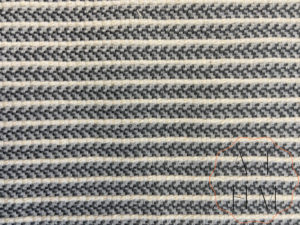
Jacquard fabric is similar to brocade and damask, as it’s thick and rather stiff. It’s made with natural fibers, like cotton or silk, or synthetic threads, like polyester.
Today, it’s most commonly a poly-cotton blend. The method of construction is what makes the jacquard fabric so special.
It has an intricate design, as it uses a strong and tight weave called the jacquard weave. Yes, it has its own weave! Long floats of thread are left behind on the back, which helps produce the pattern and is typically handwoven on a jacquard loom.
The fabric dates back as far as the 4th century in Byzantium. While it isn’t the most popular material today, it is sometimes used to make dresses, suit jackets, trousers, costumes, bathrobes, neckties, duvet covers, and drapes.
Chino Cloth
Chino cloth is another twill weave fabric with noticeable diagonal lines. It’s super durable, like twill and drill, but with a slight sheen and steeper twill lines.
For a long time, it was mostly used for military uniforms because of its high durability, comfort, and moderate stretch. Its first appearance was in the 1890s in America at a military base.
Today, it’s still used in pants and trousers and typically only uses 100% spun cotton fibers, giving it a softer feel than drill fabric. The name chino comes from the colloquial Spanish word for China, referring to Chinese cotton.
Charmeuse
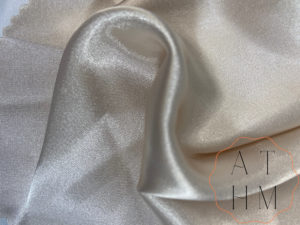
Charmeuse is a fabric that combines crepe fabric and satin. It’s made with either pure silk or synthetic silk and is commonly used for bedding, dresses, lingerie, slips, tank tops, and bathrobes.
People often mistake this fabric for satin, and they’re similar. It uses the sateen weave. However, only the front of the charmeuse is shiny, while the back is dull, like velvet. While silk fabrics originated in China, this fabric was extraordinarily popular in France around the 1500s.
This fabric is elegant and one of the heavier silk fabrics, and slightly thicker. For this reason, it’s better for bedding and home textiles than clothing.
Organdie
Organdie fabric, referred to as Swiss organdy, is a plain weave cotton fabric. It originated in Switzerland around the 18th century.
This semi-sheer fabric is known for its “crispiness,” meaning it’s very stiff and folds rather than drapes. However, it’s very delicate and most commonly used in ceremonies like weddings. The material is rigid but not rough, with a semi-soft texture.
It can make dresses, eveningwear, baby clothing, children’s clothing, collars, and shirt cuffs. It’s one of the most unusual and alluring textures, creating a captivating effect when worn.
Drill
Drill fabric is one of the most durable varieties of cotton fabric, made using the twill weave, which results in a diagonal pattern. It’s most commonly used and recognized as a khaki material to make trousers.
Drill fabric can last a long time and put up with a lot of use, as its tight and thick weave makes it resistant to snags or tears. While drill material should be a natural fabric, it can be made with polyester and other synthetic materials.
People often liken this fabric to twill, and they are very similar. However, drill fabric is a type of twill that is more tightly woven with thick yarns.
The exact origins are unknown, but it’s suspected it came about in the 1700s. The invention of the cotton gin made this fabric much easier to produce.
Madras
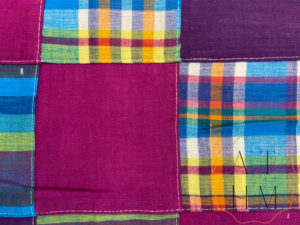
Madras is another lightweight cotton fabric. Madras is a handwoven fabric, usually with a plain weave and sometimes a twill weave. It typically has soft and muted color with patterns like plaid or stripes.
It originated in the Madras region in India in the 13th century. It’s most common to make casual shirts and dresses with plaid patchwork. It’s also a common material for summer shorts and children’s play clothing.
Madras has a distinct evenness in the pattern, and the colored threads meld together beautifully. Many scarves and shawls also use this material.
Tulle
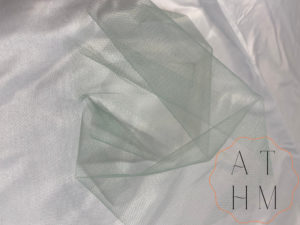
Tulle is a super romantic and flowy material. It’s common in multi-layered gowns, like wedding dresses or costumes. It is a fine mesh or netted fabric that is sheer and lightweight.
It originated during the 1800s in Tulle, France, and has had a place in high fashion ever since. A milestone for this fabric occurred when Queen Victoria wore a tulle wedding gown.
Tulle can use a variety of weaves as long as they’re open enough to create the netted appearance and texture. Manufacturers make it with silk, cotton, nylon, or rayon. The material used will determine how soft or rough the netted material is.
Twill
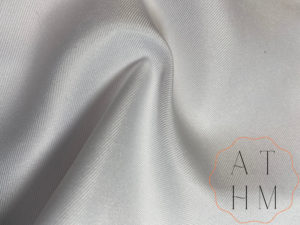
Twill fabric can use a variety of materials, both synthetic and natural. The twill weave sets this fabric apart, creating a noticeable diagonal ribbing pattern.
The origins are unknown, but many assume the fabric originated in Old England due to the name. It’s common in jeans, slacks, shirts, and bedding. People often compare twill to corduroy, as they have a similar appearance. But twill is thinner with fine threads.
Technically, fabrics like denim are a type of twill fabric. But any fabric featuring those distinct diagonal lines is a twill material. Despite the thinner threads, Twill is a durable material that can handle a lot of wear and tear.
Cheesecloth
Cheesecloth is similar to muslin. Some people use the fabrics interchangeably, but some slight differences are worth noting.
Cheesecloth typically has a much wider weave, and muslin already has an open weave, so this is a super open weave. The material has been around for thousands of years. But the term cheesecloth and its place in the kitchen only came about in the 1960s.
Cheesecloth is an open plain weave fabric that uses 100% cotton. You rarely see it in fashion. Instead, this material found its home in the kitchen as a material to help squeeze and drain ingredients of excess liquid, like cheese!
Final Thoughts
The complexity of different fabrics can be overwhelming. Hopefully, this list gave you an idea of the minute differences between some of these textiles.
In the end, most fabric differences come down to the type of weave and the fibers spun to make the material.
But small things like combed threads, brushed fibers, tight weaves, or open weaves can make all the difference in the final product.
